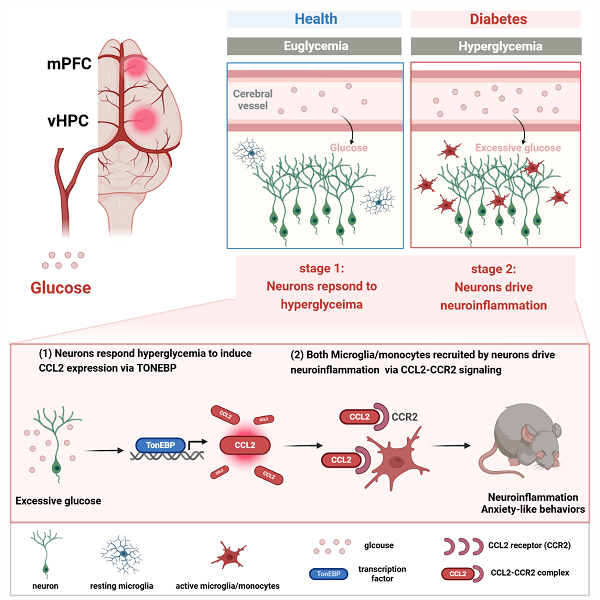Researchers Decode Neuronal CCL2 as Key Bridge Between Diabetes and Mental Disorders
Diabetes mellitus (DM) remains a major global health challenge, characterized by chronic hyperglycemia. Studies have shown a significantly higher prevalence of anxiety disorders in diabetic populations where anxiety symptoms impair treatment adherence and exacerbate disease progression. However, effective interventions for diabetes-anxiety comorbidity remain limited, partly due to metabolic side effects from conventional anti-anxiety medications.
The classical "central insulin resistance" theory posited this mechanism as the primary driver of anxiety in diabetes, yet recent animal studies revealed that global brain insulin receptor knockout mice lack anxiety phenotypes. These findings challenged this classical theory, highlighting the need to explore alternative pathogenic mechanisms. Elevated peripheral chemokine levels in both diabetic and psychiatric patients have led to the hypothesis that hyperglycemia may trigger anxiety through specific chemokines, such as C-C motif ligand 2 (CCL2).
A study published in Nature Metabolism on May 6, a research team led by Prof. LI Jia from the Shanghai Institute of Materia Medica (SIMM) of Chinese Academy of Sciences, and Prof. ZANG Yi from Lingang Laboratory, found that hyperglycemia increases anxiety-like behavior in diabetic mice by boosting neuronal CCL2 and triggering neuroimmune responses. This study is the first to identify chemokine CCL2 in neurons as a key driver of anxiety behavior in the diabetic context, providing a novel perspective on the pathogenesis of diabetes-associated mental disorders.
Using diabetic mouse models, combined with behavioral assays and multi-omics analyses, the study identified elevated CCL2 levels in anxiety-related brain regions and peripheral tissues. Global or brain-specific CCL2 knockout experiments confirmed that only central CCL2 depletion alleviated anxiety.
Mechanistically, hyperglycemia transcriptionally upregulated neuronal CCL2 via the Transcription factor tonicity-responsive enhancer-binding protein(TonEBP) pathway. CCL2 then bound to its receptor CCR2, activating microglia and peripheral monocytes to drive neuroinflammation. Clinical transcriptomic analyses revealed marked activation of the TonEBP-CCL2-inflammatory pathway in diabetic human brains, highlighting translational relevance.
This study uncovered a novel pathway through which hyperglycemia induces anxiety via neuronal CCL2 and neuroimmune activation, challenging the classical “central insulin resistance” theory. Transcriptomic analyses of human diabetic brain tissue further confirmed upregulation of the TonEBP-CCL2 axis in clinical samples, supporting the translational relevance of the findings. The study not only identified a promising therapeutic target for diabetes-related anxiety but also provided a theoretical basis for developing safer and more effective treatments.

The involvement of neuronal CCL2 expression, activated by hyperglycemia, in the modulation of anxiety disorders in the context of diabetes. (Image by PAN Kaijun)
Contact:
JIANG Qingling
Shanghai Institute of Materia Medica, Chinese Academy of Sciences
E-mail: qljiang@stimes.cn




